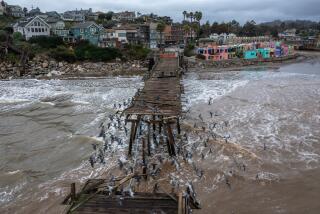Sinking Chesapeake Bay a Microcosm of World Trends, Scientists Say : Environment: They hope to study the effects of rising sea levels accelerated by global warming.
- Share via
LOWER HOOPER ISLAND, Md. — One homeowner runs a lawn mower over the salt marsh grass that grows in his front yard, ignoring fiddler crab holes spaced every few inches apart.
In a neighbor’s yard, shallow pools of water become mud flats during dry spells, making mowing unnecessary. Farther south, along the shoreline of this remote spit of land in mid-Chesapeake Bay, whole dwellings are settling into the water.
Despite these major clues, many residents of this Eastern Shore community refuse to believe what scientists say is inevitable: Their island is slowly sinking beneath the waves of the enormous estuary.
“Local people here have a lot of anecdotal evidence that the water’s as high on the stump as it was 20 or 30 years ago,” says Michael Kearney, a University of Maryland geography professor. “I don’t know if they’re looking at a different stump, but it’s not true.”
Scientists are convinced, in fact, that the whole Chesapeake Bay is sinking. And some are using the bay as a laboratory microcosm of coastal environments around the world. They are hoping to predict the effects of a possible acceleration of rising sea levels as a result of global warming.
“What’s going on in the Chesapeake Bay is going on worldwide,” says Duncan M. Fitzgerald, Boston University geologist. “I don’t think people understand that an increase in the rate of rise of sea level is going to have a devastating, cataclysmic effect.”
An accelerated sea-level rise would inundate low-lying coastal areas around the world within the lifetimes of many present inhabitants. In addition, it could wipe out entire nations, such as the Maldives, an archipelago in the Indian Ocean whose average island is less than a square mile.
“The Chesapeake Bay has just about every type of environment in the world except a major river delta and coral reef,” says Stephen P. Leatherman, a University of Maryland geographer. “It has small islands, low-lying marshy areas and eroding cliffs, representative of much of the world’s coast.”
Whether human activities such as burning fossil fuels have triggered an acceleration in global warming has yet to be proved. But for whatever reason, scientists estimate that the world’s sea level has risen between 5 and 6 inches in the last century.
They cite an average global temperature rise of about 1 degree Fahrenheit during that period.
Water tends to expand when heated, and another suspected major cause of the rising level, scientists say, is water from melting glaciers in mid-latitude areas such as the Alps.
The amount of sea-level rise relative to land varies from place to place, depending partly on whether the adjacent land is also sinking--a phenomenon usually associated with withdrawal of ground water for agricultural and industrial uses.
In the case of Chesapeake Bay, Kearney and J. Court Stevenson of the University of Maryland’s Horn Point Environmental Laboratories in Cambridge, Md., believe the entire estuary is sinking, weighed down by accumulating sediment washed into it from rivers.
“Sea level only rises a few fractions of an inch per year,” Leatherman says. “But every year it adds up. We tend to be a crisis-oriented society, and we wait until the disaster happens. These things like sea-level rise, with long lead times, tend to get ignored until they kind of burst through the seams.”
Some affluent enclaves may be able to stave off the inevitable by building seawalls. But less prosperous areas, such as the venerable watermen’s community of Crisfield, on Maryland’s Eastern Shore, may be less fortunate over the next century or two. Already, storms sometimes drive salt water down Main Street.
“We’ll certainly fortify Baltimore, Annapolis, and Washington against sea-level rise in the future,” Leatherman says. “But a place like Crisfield can’t afford it.”
Nor, in all likelihood, can Lower Hooper Island.
At low tide on a bitter winter day, auto parts store manager Eddy Dean, 20, pokes around the ruins of an abandoned house trailer at the south end of the island. It is pitched at a 30-degree angle, one end standing on solid ground and the other lying in a mud flat that will be under water by sundown.
Dean, who lives a few miles north in Fishing Creek, is hunting for arrowheads uncovered periodically by the advancing waves.
“There was land around here as recently as a year ago,” he says, picking his way through tidal pools.
He retrieves a glistening black arrowhead but passes over another relic: the rusty remains of an electric wall lamp, evidently from the trailer, already half buried in the soft clay.






